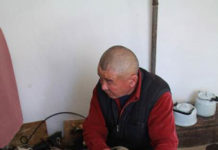Processing of leather, tailoring of leather clothes, footwear, hats, accessories, production of leather household items are spread across Kazakhstan. The most common material is calfskin, and less frequent are camel skin, horse skin, sheepskin and goatskin.

Traditional technique of leather processing is used along with modern methods. The leather is used to produce men’s belts (kumys beldyk); hunting belt with accessories (kyseh beldyk with powder flask, pouch, fire striker, and sheath for a knife); women’s belt (belbeu); traditional footwear (yetyk, kebys, myasy); leather braided whip (khamshy), four, six and eight strand whip (used for horse riding); twelve and fourteen strand whip (used for protection from wolf attack); a quiver for arrows; a sheath for knives, swords, and sabers; leather shields. There are also leather vessels for mare’s milk: kauhar (flat vessel with narrow neck), torsykh (a vessel with rounded handles), mess (water skin), sabah (a large vessel tailored from goatskin).
Traditional fur hats are widespread in Kazakhstan, namely tymakh and boryk with a lining made from fox, wolf, muskrat or mink fur and pushpakh tymakh made from fox paws; as well traditional men’s clothes (shapan and zharghakh) light coat made from light and soft suede and decorated with fine silk embroidery. Kazakh suede was one of the most valuable goods of the Silk Road and was traded as expensively as Chinese silk.
One of the most common techniques used by Kazakh artisans is hot stamping on leather with metal plates called khalyp. Embossing is made on soaked leather on the underside using special wooden plates with a desired carved design. Leather is clamped between two wooden plates and left to air-dry naturally.
The design used for decorating leather is similar to the one used for making carpets. The central field filled with khoshkhar muyiz (sheep horn pattern) and khos myuiz (a cross-piece made of paired sheep horns). For the border, usually a plant design is used. The leather can be decorated with shaped metal plates with silver inlay. Embossed leather can be used for decorating wooden chests (zhaghlan). Along with embossing, incrustation with coloured leather (kok saur), velvet and gold embroidery on leather is used.
Leather can be dyed with pigments resistant to fading. Pigments were made from plants (henna, pine bark, madder and it roots) and minerals. Traditional leather processing and dyeing techniques are widely used in Shubarkuduk (Western Kazakhstan), which also hosts a school for teaching these techniques to young people.
Leather braiding and other leather decorating techniques are widely used by modern artists. These include N. Zhakybayev, R. Seifullah, K.Seyfullin, Zh. Umbetov, , M. Asanbayev, K. Aipkaliyev, N. Kalieyv, Sh. Zhumashev, Zh. Naushbayev, B. Beysbekov, A. Nazarkul, Ye. Askarov, A. Orazgaly, T. Kuzhanbayev, R. Berdymbetov, S. Saliyev, D. Shokparov, R. Yrisbayev and D. Arkhipkin.





